The amount of information and the intensity of emotions that information elicits in today's world is actually impossible for our minds to process both psychologically and biologically. There is, therefore, no way for us in a globalized world to have the time and energy to follow even the most important world events and their coverage across various media. It is helpful to know where to turn for reliable information and, ideally, to assess its legitimacy ourselves. Here are some hints on how to navigate the online space carefully and to not be misled.
Narratives and recommendations online
Even the most professionalized and independent bodies such as Wikipedia are not free from error or even manipulation. Recent research by Jan Grabowski and Shira Klein reports on the intentional distortion of the history of the Holocaust by "an organised nationalist group communicating outside Wikipedia". In the article Wikipedia's Intentional Distortion of the History of the Holocaust, the authors describe the phenomenon of whitewashing the role of Polish society in the Holocaust and reinforcing stereotypes about Jews. Even minimiz the importance of some facts and exaggerating others can turn into misleading insinuations or effectively outright disinform the public that is reading such Wikipedia articles. Wikipedia editors can introduce readers to “scientific authorities,” even though the individuals have no scientific background in the field under discussion or are not involved in science at all. Moreover, the lively discussions and frequent editing changes that take place on Wikipedia are not easily comprehensible or approachable for the average reader. Readers may not be aware that Wikipedia editors could be citing established or marginal researchers on a given topic. Highlighting and amplifying one researcher while downplaying others to create new narratives is one way of producing disinformation.
Another example of how online content can be disinformation is that of a non-existent restaurant that was ranked as the number one best-rated restaurant on the TripAdvisor website. This case shows how easily we can be fooled. It turned out that it was possible, within seven months, to create a fictitious “restaurant” on the well-known travel business recommendation portal, to which virtual queues lined up for months, and even sought employment and offered delivery of goods.
 Photo of the "Shed" - a fake restaurant from TripAdvisor. Source: https://www.bbc.co.uk/programmes/p05qc0xk
Photo of the "Shed" - a fake restaurant from TripAdvisor. Source: https://www.bbc.co.uk/programmes/p05qc0xk
In the overload of information, then, how do we remain vigilant and clear in our judgment. How can we discern: where is the provocation, the attempt to make money, or the manipulation?
● Pay attention to topics in the media that polarize public opinion - this is where you can often expect possible abuse, distortion and disinformation.
● Read different points of view and check the reliability and quality of the sources cited by the authors. For example, information that seems particularly emotional or shocking can be checked in 2-3 different recognized sources of news
● If you use websites or social media, be aware of the deficiencies of the social process for creating recommendations and reviews. You can learn the basics of using media in our free online course.
If you see a competition, check who's organizing it
Did you find information about a competition that promises a cash reward? A promotional campaign online? Find out who's behind it and whether it's an impersonation.
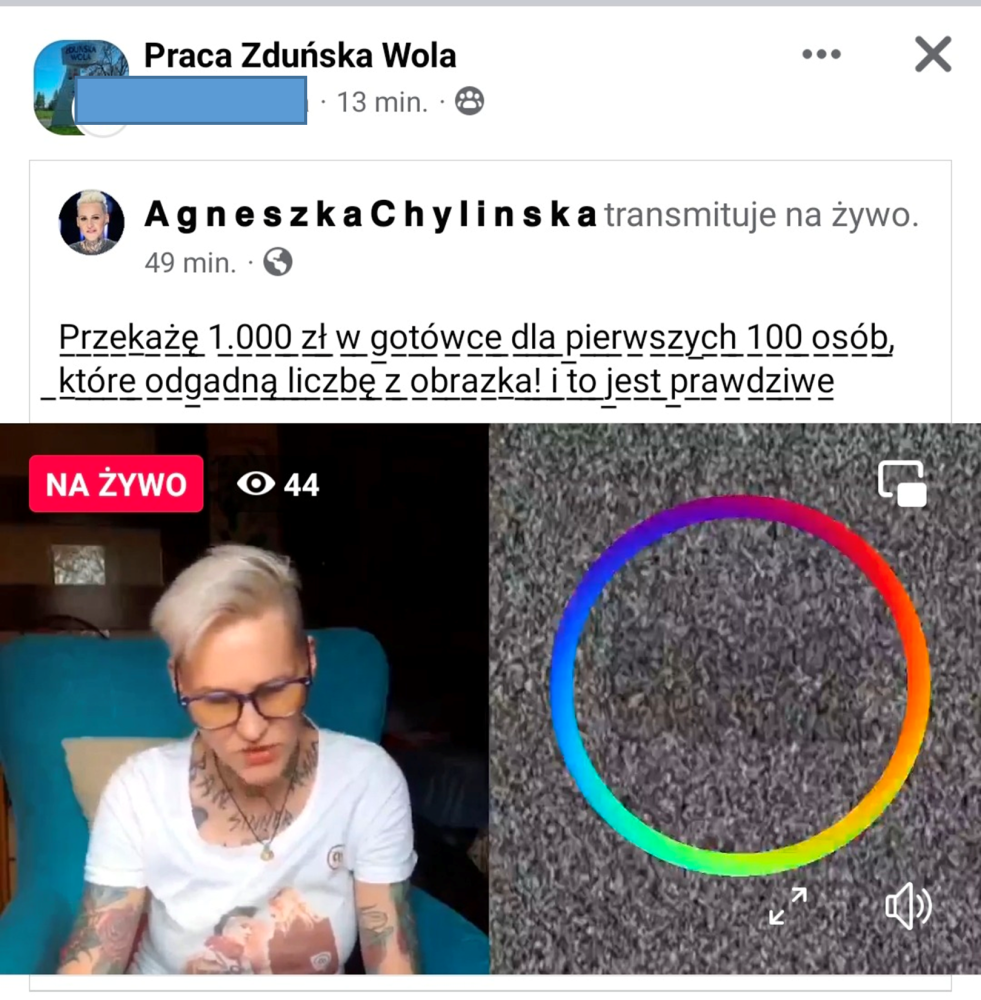 On the screen above: “I will give 1K PLZ in cash to the first 100 people who will guess the number in the picture. This is for real!”
On the screen above: “I will give 1K PLZ in cash to the first 100 people who will guess the number in the picture. This is for real!”
Would any of you expect the famous Polish singer Agnieszka Chylińska to host a competition that involves guessing what number is visible on a piece of concrete? In a world of quiz shows and entertainment programs competing with each other for popularity, the answer is:Yes. Many people are willing to believe that the singer is giving away money on Facebook.
So how do you spot a hoax?
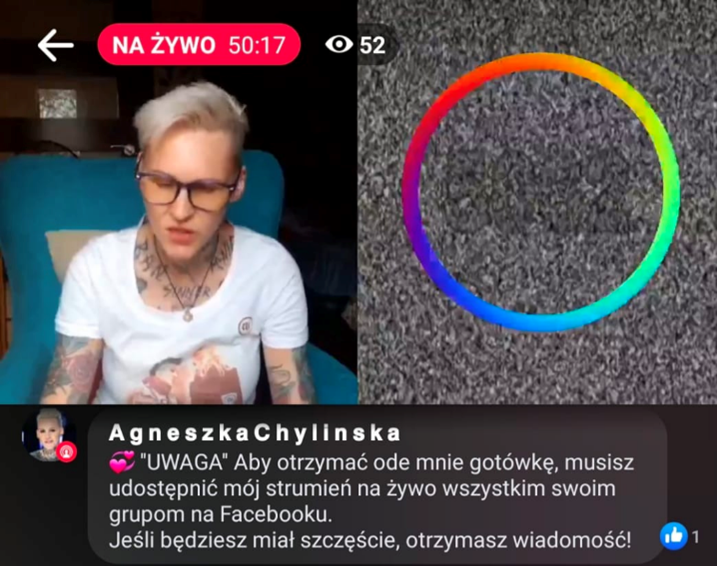 On the screen above: “Attention! To get cash from me, you have to share may live in all of your Facebook groups. If you are lucky, you will get a message!”
On the screen above: “Attention! To get cash from me, you have to share may live in all of your Facebook groups. If you are lucky, you will get a message!”
By clicking on Agnieszka Chylinska's alleged profile, we are redirected to a fanpage which has barely two likes and seven followers. Such a small number of likes makes it quite clear that this is not the real profile of a well-known celebrity. We are now one click away from finding out who is behind the post, which impersonates the singer and was spread on one Facebook group. Notice also that the spacing of the letters A g n i e s z k a C h y l i n s k a is wider than usual, which is characteristic of this type of scam.
 If you come across a similar post, be sure to screenshot it and tell a friend about how you discovered a scam online.
If you come across a similar post, be sure to screenshot it and tell a friend about how you discovered a scam online.
Hot topic vs. groups on Facebook
Highly polarizng topics, such as tragedies or mass protests, can arouse the most intense emotional reactions. Hot topics that feel urgent and divisive can easily be used to manipulate, troll, and also exploit someone's involvement. In today’s public debate, such topics are, for example: abortion laws (e.g. in Poland and the United States), school shootings (in the United States), global pandemics, humanitarian crisis, accidents.
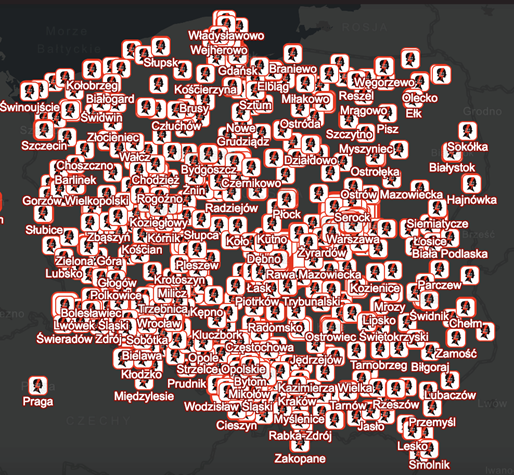 Map of the 'October 2020' strikes against stricter abortion laws in Poland. Source: http://strajkkobiet.eu/mapa-wydarzen/
Map of the 'October 2020' strikes against stricter abortion laws in Poland. Source: http://strajkkobiet.eu/mapa-wydarzen/
On 22 October 2020 the Constitutional Court tightened abortion laws in Poland. The ruling on the unconstitutionality of abortion laws in the case of severe fetal disability sparked mass protests in many cities. Mobilisation and support for the protests continued in the online space.
On 23 October, a Facebook group was set up to allegedly support women. The group used the strike's most well-known and emotional slogan “This is war” and the encouragement of an evening protest announced by the All-Poland Women's Strike. Facebook friends invited each other to join the group as a gesture of mobilization and solidarity with women.
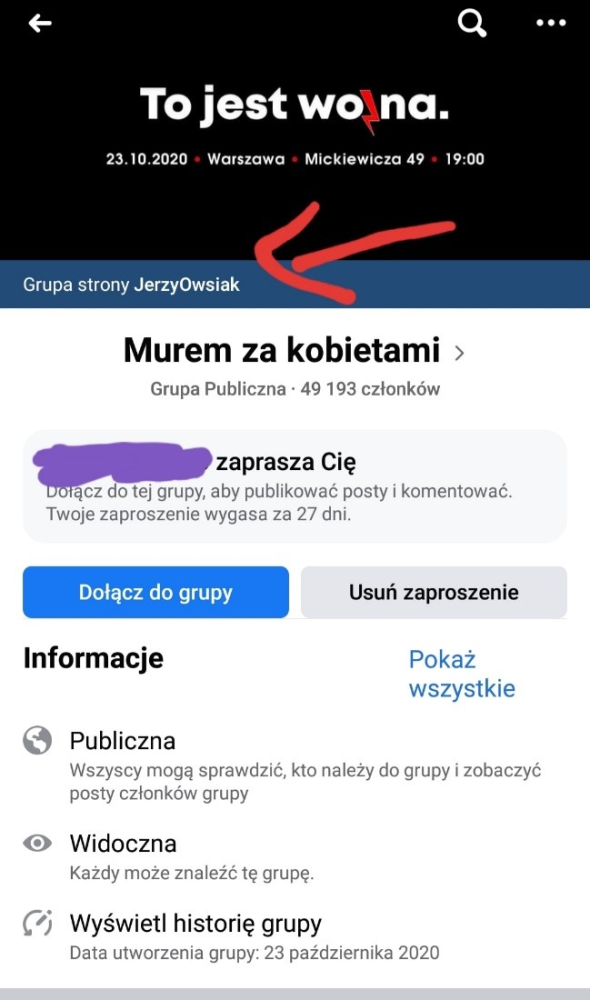 Facebook groups can be created by any person. The 'Support for Women' group was allegedly founded by a well-known public figure, Jerzy Owsiak. The arrow in the photo above pointed to 'JerzyOwsiak' (spelled without a space between the first and last names) as the founder.
Facebook groups can be created by any person. The 'Support for Women' group was allegedly founded by a well-known public figure, Jerzy Owsiak. The arrow in the photo above pointed to 'JerzyOwsiak' (spelled without a space between the first and last names) as the founder.
The profile of "JerzyOwsiak" and, as it turned out, the fanpage, was easy to find because the administrator had published a post/announcement from the fanpage in the group. The post encouraged people to "share the group everywhere and with everyone."
 The advert above says: “Dears, share this group everywhere! On your walls, groups! We can’t allow for such a drastic move! We won’t allow women to be affected! You are also welcome to invite your friends to join this group! We are strong together!
The advert above says: “Dears, share this group everywhere! On your walls, groups! We can’t allow for such a drastic move! We won’t allow women to be affected! You are also welcome to invite your friends to join this group! We are strong together!
Clicking on the "JerzyOwsiak" fan page, revealed a page impersonating the social activist, which had clearly been set up only recently as it had only 405 likes, while Jerzy Owsiak's verified fan page has over one million likes. The fake fan page also incorrectly suggested that Jerzy Owsiak is a politician rather than a widely recognized social activist who had never held political office.
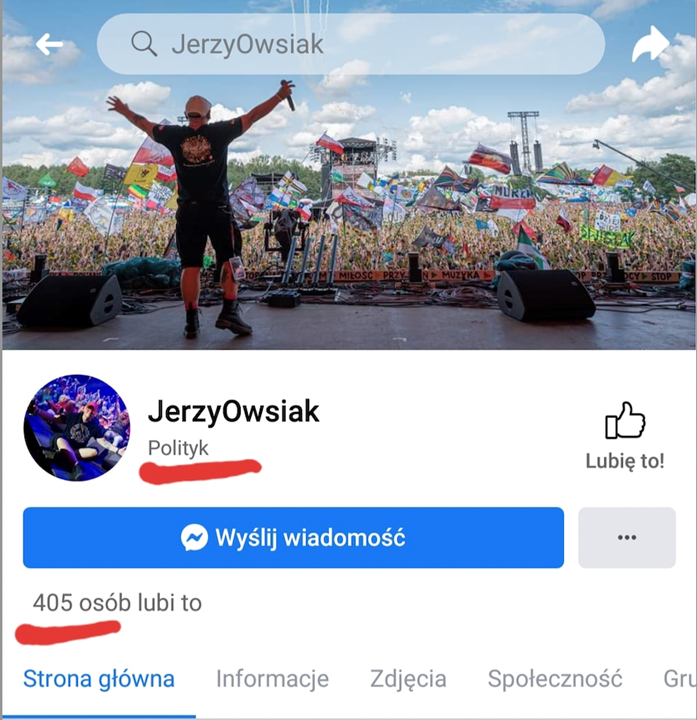 The group's administrators had the power to approve posts, which gave them full control over the content. They did not approve posts that pointed out the page is impersonating of Jurek Owsiak or that asked who was behind the newly formed group. Such questions also appeared in the comments, but were lost in the stream of other comments and new posts expressing outrage and calls for protest.
The group's administrators had the power to approve posts, which gave them full control over the content. They did not approve posts that pointed out the page is impersonating of Jurek Owsiak or that asked who was behind the newly formed group. Such questions also appeared in the comments, but were lost in the stream of other comments and new posts expressing outrage and calls for protest.
March against violence
The Facebook group, March for Our Lives, was created on 20 February 2018 under the pretext of mobilizing people to participate in a march against gun violence. A week earlier, the shooting in Parkland, Florida, had taken place.
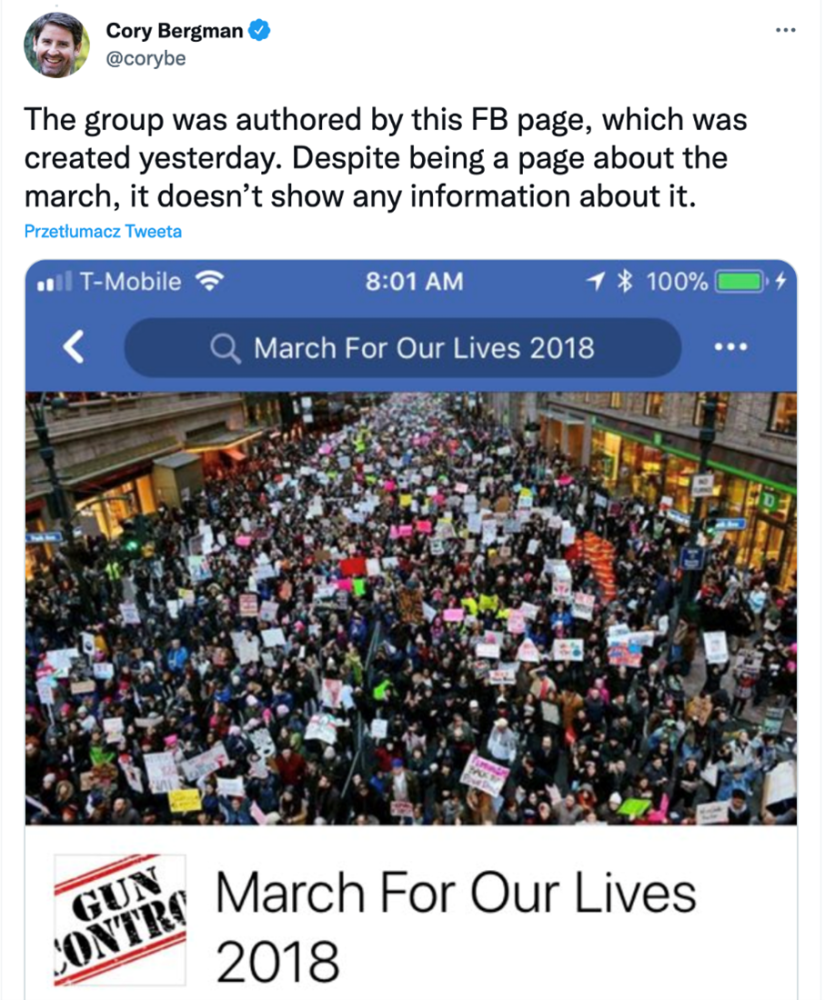 Source: https://twitter.com/corybe/status/966342567573909505
Source: https://twitter.com/corybe/status/966342567573909505
It turned out that the group's administrators were misleading group members, accepting offensive posts and spreading conspiracy theories. It is noteworthy that, at the same time, similar groups began to appear with the name of the city in the title reporting on marches in other locations throughout the country.
How not to get fooled?
When a tragic event or scandal takes place, we naturally experience different emotions. We try to check the information as soon as possible, see the coverage, see the pictures and find out exactly what happened. In such moments, we often check social media. Social media groups are formed suddenly to report on what is happening. Here are some tips on how not to be tricked when joining and following such groups:
● Checkat the groups you join. The fact that someone recommends or invites you to join a particular group does not mean that the person verified the group. Check it yourself.
● Many popular groups in Poland are groups that begin their name with: "Supporters_name_politics_journalist", "Solidarity_with_the_judge_activist_actor", "Standing_with_the_minister_journalist_TV_programme", "Group_without_censorship", and many others. Such titles should immediately alert you that the message in the group are likely one-sided and biased.
● Review what narratives are emerging in the group and who is creating them - are the narratives hateful, sympathetic to a political party, in the spirit of conspiracy theories.
● Check who administers the group - can you verify whether the person is real or whether they are impersonating someone.
● Check the group's history - was it formed recently, has it ever changed its name:
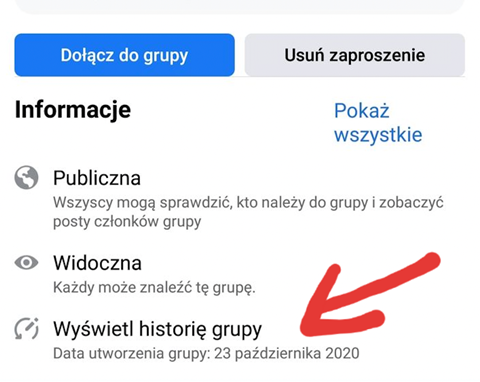 The arrow above indicates the date of the creation of the group: 23 October, 2020.
The arrow above indicates the date of the creation of the group: 23 October, 2020.
What next?
We do not have to remain passive. If we have already made some effort to verify the group and its administrators, we can take concrete action:
● Report the group as an impersonator;
● Go to the suspicious profile/fan page and report it too;
● Write a post on your own wall warning against this group;
● Leave the group or unfollow the fan page;
● Share this or a similar article with others.
Background illustration by luca sammacoro, PEXELS stock.